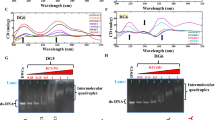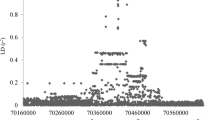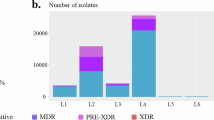Abstract
A screen for TBX1 gene mutations identified two mutations in patients with some features compatible with the 22q11.2-deletion syndrome but with no deletions. One is a de novo missense mutation and the other is a 5′ untranslated region (5′UTR) C>T change that affects a nucleotide with a remarkable trans-species conservation. Computer modelling shows that the 5′UTR change is likely to affect the mRNA structure and in vitro translation experiments demonstrate that it produces a twofold increase in translation efficiency. Recently, duplications in the 22q11.2 region were reported in patients referred for fragile-X determination because of cognitive and behavioural problems. Because the 5′UTR nucleotide change may be a functional equivalent of a duplication of the TBX1 gene, we decided to screen 200 patients who had been referred for fragile-X determination and 400 healthy control individuals. As a result, we found the 5′UTR mutation to be present in three patients with mental retardation or behavioural problems and absent in control individuals of the same ethnic background. This observation suggests that it may be reasonable to screen for such mutation among patients with unspecific cognitive deficits and we provide an easy and quick way to do it with an amplification refractory mutation system (ARMS) approach. To our knowledge, this is the first human mutation showing that TBX1 is a candidate causing mental retardation associated with the 22q11.2 duplication syndrome.
Similar content being viewed by others
Log in or create a free account to read this content
Gain free access to this article, as well as selected content from this journal and more on nature.com
or
References
Ryan AK, Goodship JA, Wilson DI et al: Spectrum of clinical features associated with interstitial chromosome 22q11 deletions: a European collaborative study. J Med Genet 1997; 34: 798–804.
de La Rochebrochard C, Joly-Helas G, Goldenberg A et al: The intrafamilial variability of the 22q11.2 microduplication encompasses a spectrum from minor cognitive deficits to severe congenital anomalies. Am J Med Genet A 2006; 140A: 1608–1613.
Ensenauer RE, Adeyinka A, Flynn HC et al: Microduplication 22q11.2, an emerging syndrome: clinical, cytogenetic, and molecular analysis of thirteen patients. Am J Hum Genet 2003; 73: 1027–1040.
Hassed SJ, Hopcus-Niccum D, Zhang L, Li S, Mulvihill JJ : A new genomic duplication syndrome complementary to the velocardiofacial (22q11 deletion) syndrome. Clin Genet 2004; 65: 400–404.
Portnoi MF, Lebas F, Gruchy N et al: 22q11.2 duplication syndrome: two new familial cases with some overlapping features with DiGeorge/velocardiofacial syndromes. Am J Med Genet A 2005; 137: 47–51.
Sparkes R, Chernos J Dicke F : Duplication of the 22q11.2 region associated with congenital cardiac disease. Cardiol Young 2005; 15: 229–231.
Yobb TM, Somerville MJ, Willatt L et al: Microduplication and triplication of 22q11.2: a highly variable syndrome. Am J Hum Genet 2005; 76: 865–876.
Jerome LA, Papaioannou VE : DiGeorge syndrome phenotype in mice mutant for the T-box gene, Tbx1. Nat Genet 2001; 27: 286–291.
Lindsay EA, Vitelli F, Su H et al: Tbx1 haploinsufficieny in the DiGeorge syndrome region causes aortic arch defects in mice. Nature 2001; 410: 97–101.
Merscher S, Funke B, Epstein JA et al: TBX1 is responsible for cardiovascular defects in velo-cardio-facial/DiGeorge syndrome. Cell 2001; 104: 619–629.
Liao J, Kochilas L, Nowotschin S et al: Full spectrum of malformations in velo-cardio-facial syndrome/DiGeorge syndrome mouse models by altering Tbx1 dosage. Hum Mol Genet 2004; 13: 1577–1585.
Paylor R, Glaser B, Mupo A et al: Tbx1 haploinsufficiency is linked to behavioral disorders in mice and humans: implications for 22q11 deletion syndrome. Proc Natl Acad Sci USA 2006; 103: 7729–7734.
Yagi H, Furutani Y, Hamada H et al: Role of TBX1 in human del22q11.2 syndrome. Lancet 2003; 362: 1366–1373.
Conti E, Grifone N, Sarkozy A et al: DiGeorge subtypes of nonsyndromic conotruncal defects: evidence against a major role of TBX1 gene. Eur J Hum Genet 2003; 11: 349–351.
Gong W, Gottlieb S, Collins J et al: Mutation analysis of TBX1 in non-deleted patients with features of DGS/VCFS or isolated cardiovascular defects. J Med Genet 2001; 38: E45.
Rauch A, Devriendt K, Koch A et al: Assessment of association between variants and haplotypes of the remaining TBX1 gene and manifestations of congenital heart defects in 22q11.2 deletion patients. J Med Genet 2004; 41: e40.
Newton CR, Graham A, Heptinstall LE et al: Analysis of any point mutation in DNA. The amplification refractory mutation system (ARMS). Nucleic Acids Res 1989; 17: 2503–2516.
Stoller JZ, Epstein JA : Identification of a novel nuclear localization signal in Tbx1 that is deleted in DiGeorge syndrome patients harboring the 1223delC mutation. Hum Mol Genet 2005; 14: 885–892.
Pickering BM, Willis AE : The implications of structured 5' untranslated regions on translation and disease. Semin Cel lDev Biol 2005; 16: 39–47.
Zuker M : Mfold web server for nucleic acid folding and hybridization prediction. Nucleic Acids Res 2003; 31: 3406–3415.
Kozak M : Circumstances and mechanisms of inhibition of translation by secondary structure in eucaryotic mRNAs. Mol Cell Biol 1989; 9: 5134–5142.
Edelmann L, Pandita RK, Spiteri E et al: A common molecular basis for rearrangement disorders on chromosome 22q11. Hum Mol Genet 1999; 8: 1157–1167.
McDonald-McGinn DM, Tonnesen MK, Laufer-Cahana A et al: Phenotype of the 22q11.2 deletion in individuals identified through an affected relative: cast a wide FISHing net!. Genet Med 2001; 3: 23–29.
Guris DL, Duester G, Papaioannou VE, Imamoto A : Dose-dependent interaction of Tbx1 and Crkl and locally aberrant RA signaling in a model of del22q11 syndrome. Dev Cell 2006; 10: 81–92.
Guris DL, Fantes J, Tara D, Druker BJ, Imamoto A : Mice lacking the homologue of the human 22q11.2 gene CRKL phenocopy neurocristopathies of DiGeorge syndrome. Nat Genet 2001; 27: 293–298.
Abu-Issa R, Smyth G, Smoak I, Yamamura K, Meyers EN : Fgf8 is required for pharyngeal arch and cardiovascular development in the mouse. Development 2002; 129: 4613–4625.
Bachiller D, Klingensmith J, Shneyder N et al: The role of chordin/Bmp signals in mammalian pharyngeal development and DiGeorge syndrome. Development 2003; 130: 3567–3578.
Frank DU, Fotheringham LK, Brewer JA et al: An Fgf8 mouse mutant phenocopies human 22q11 deletion syndrome. Development 2002; 129: 4591–4603.
Stalmans I, Lambrechts D, De Smet F et al: VEGF: a modifier of the del22q11 (DiGeorge) syndrome? Nat Med 2003; 9: 173–182.
Roberts C, Ivins SM, James CT, Scambler PJ : Retinoic acid down-regulates Tbx1 expression in vivo and in vitro. Dev Dyn 2005; 232: 928–938.
Zhang L, Zhong T, Wang Y, Jiang Q, Song H, Gui Y : TBX1, a DiGeorge syndrome candidate gene, is inhibited by retinoic acid. Int J Dev Biol 2006; 50: 55–61.
Wang XD : Alcohol, vitamin A, and cancer. Alcohol 2005; 35: 251–258.
Acknowledgements
This work was supported by grants from and FIS-PI02654 and FIS-C03/05. We thank Joan Fibla for help with the statistical analysis and for control DNA samples.
Author information
Authors and Affiliations
Corresponding author
Additional information
Supplementary Information accompanies the paper on European Journal of Human Genetics website (http://www.nature.com/ejhg)
Supplementary information
Rights and permissions
About this article
Cite this article
Torres-Juan, L., Rosell, J., Morla, M. et al. Mutations in TBX1 genocopy the 22q11.2 deletion and duplication syndromes: a new susceptibility factor for mental retardation. Eur J Hum Genet 15, 658–663 (2007). https://doi.org/10.1038/sj.ejhg.5201819
Received:
Revised:
Accepted:
Published:
Issue date:
DOI: https://doi.org/10.1038/sj.ejhg.5201819
Keywords
This article is cited by
-
Mayer-Rokitansky-Küster-Hauser syndrome with 22q11.21 microduplication: a case report
Journal of Medical Case Reports (2021)
-
Copy number elevation of 22q11.2 genes arrests the developmental maturation of working memory capacity and adult hippocampal neurogenesis
Molecular Psychiatry (2018)
-
A 3 base pair deletion in TBX1 leads to reduced protein expression and transcriptional activity
Scientific Reports (2017)
-
Systematic analysis of copy number variants of a large cohort of orofacial cleft patients identifies candidate genes for orofacial clefts
Human Genetics (2016)
-
Novel TBX1loss-of-function mutation causes isolated conotruncal heart defects in Chinese patients without 22q11.2 deletion
BMC Medical Genetics (2014)



